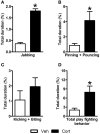Increased corticosterone in peripubertal rats leads to long-lasting alterations in social exploration and aggression
- PMID: 23576965
- PMCID: PMC3616252
- DOI: 10.3389/fnbeh.2013.00026
Increased corticosterone in peripubertal rats leads to long-lasting alterations in social exploration and aggression
Abstract
Stress during childhood and adolescence enhances the risk of psychopathology later in life. We have previously shown that subjecting male rats to stress during the peripubertal period induces long-lasting effects on emotion and social behaviors. As corticosterone is increased by stress and known to exert important programming effects, we reasoned that increasing corticosterone might mimic the effects of peripubertal stress. To this end, we injected corticosterone (5 mg/kg) on 7 scattered days during the peripuberty period (P28-P30, P34, P36, P40, and P42), following the same experimental schedule as for stress administration in our peripubertal paradigm. We measured play behavior in the homecage and, at adulthood, the corticosterone response to novelty and behavioral responses in tests for anxiety- and depression-like behaviors, aggression, and social exploration. As compared to vehicle, corticosterone-treated animals exhibit more aggressive play behavior during adolescence, increased aggressive behavior in a resident-intruder (RI) test while reduced juvenile exploration and corticosterone reactivity at adulthood. Whereas the corticosterone treatment mimicked alterations induced by the peripuberty stress protocol in the social domain, it did not reproduce previously observed effects of peripuberty stress on increasing anxiety-like and depression-like behaviors, respectively evaluated in the elevated plus maze (EPM) and the forced swim tests. Our findings indicate that increasing corticosterone levels during peripuberty might be instrumental to program alterations in the social domain observed following stress, whereas other factors might need to be recruited for the programming of long-term changes in emotionality. Our study opens the possibility that individual differences on the degree of glucocorticoid activation during peripuberty might be central to defining differences in vulnerability to develop psychopathological disorders coursing with alterations in the social realm.
Keywords: adolescence; aggressive behavior; corticosterone; emotion; puberty; sociability; stress.
Figures





Similar articles
-
Corticosterone administration immediately after peripuberty stress exposure does not prevent protracted stress-induced behavioral alterations.Psychoneuroendocrinology. 2024 Dec;170:107164. doi: 10.1016/j.psyneuen.2024.107164. Epub 2024 Aug 6. Psychoneuroendocrinology. 2024. PMID: 39146600
-
CRHR1 links peripuberty stress with deficits in social and stress-coping behaviors.J Psychiatr Res. 2014 Jun;53:1-7. doi: 10.1016/j.jpsychires.2014.02.015. Epub 2014 Feb 28. J Psychiatr Res. 2014. PMID: 24630468
-
Long-term programing of psychopathology-like behaviors in male rats by peripubertal stress depends on individual's glucocorticoid responsiveness to stress.Stress. 2018 Sep;21(5):433-442. doi: 10.1080/10253890.2018.1435639. Epub 2018 Feb 7. Stress. 2018. PMID: 29415604
-
Long-term programming of enhanced aggression by peripuberty stress in female rats.Psychoneuroendocrinology. 2013 Nov;38(11):2758-69. doi: 10.1016/j.psyneuen.2013.07.005. Epub 2013 Aug 12. Psychoneuroendocrinology. 2013. PMID: 23942011
-
Sex and age specific effects of delta-9-tetrahydrocannabinol during the periadolescent period in the rat: The unique susceptibility of the prepubescent animal.Neurotoxicol Teratol. 2016 Nov-Dec;58:88-100. doi: 10.1016/j.ntt.2016.02.005. Epub 2016 Feb 16. Neurotoxicol Teratol. 2016. PMID: 26898326 Review.
Cited by
-
Adolescence and the ontogeny of the hormonal stress response in male and female rats and mice.Neurosci Biobehav Rev. 2016 Nov;70:206-216. doi: 10.1016/j.neubiorev.2016.05.020. Epub 2016 May 24. Neurosci Biobehav Rev. 2016. PMID: 27235079 Free PMC article. Review.
-
Arginine vasotocin affects motivation to call, but not calling plasticity, in Cope's gray treefrog Hyla chrysoscelis.J Comp Physiol B. 2022 Jan;192(1):115-125. doi: 10.1007/s00360-021-01399-1. Epub 2021 Aug 16. J Comp Physiol B. 2022. PMID: 34401940
-
Detailed classification of swimming paths in the Morris Water Maze: multiple strategies within one trial.Sci Rep. 2015 Oct 1;5:14562. doi: 10.1038/srep14562. Sci Rep. 2015. PMID: 26423140 Free PMC article.
-
Behavioral characterization of a novel Cisd2 mutant mouse.Behav Brain Res. 2021 May 7;405:113187. doi: 10.1016/j.bbr.2021.113187. Epub 2021 Feb 18. Behav Brain Res. 2021. PMID: 33610659 Free PMC article.
-
Social isolation induces sexually aggressive behaviour in male Wistar rats.BMC Neurosci. 2025 Feb 26;26(1):15. doi: 10.1186/s12868-025-00932-0. BMC Neurosci. 2025. PMID: 40011829 Free PMC article.
References
-
- Bazak N., Kozlovsky N., Kaplan Z., Matar M., Golan H., Zohar J., et al. (2009). Pre-pubertal stress exposure affects adult behavioral response in association with changes in circulating corticosterone and brain-derived neurotrophic factor. Psychoneuroendocrinology 34, 844–858 10.1016/j.psyneuen.2008.12.018 - DOI - PubMed
LinkOut - more resources
Full Text Sources
Other Literature Sources
Research Materials

